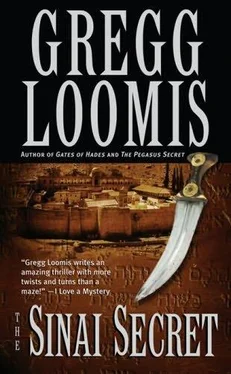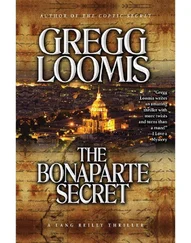Gregg Loomis - The Sinai Secret
Здесь есть возможность читать онлайн «Gregg Loomis - The Sinai Secret» весь текст электронной книги совершенно бесплатно (целиком полную версию без сокращений). В некоторых случаях можно слушать аудио, скачать через торрент в формате fb2 и присутствует краткое содержание. Жанр: Триллер, на английском языке. Описание произведения, (предисловие) а так же отзывы посетителей доступны на портале библиотеки ЛибКат.
- Название:The Sinai Secret
- Автор:
- Жанр:
- Год:неизвестен
- ISBN:нет данных
- Рейтинг книги:5 / 5. Голосов: 1
-
Избранное:Добавить в избранное
- Отзывы:
-
Ваша оценка:
- 100
- 1
- 2
- 3
- 4
- 5
The Sinai Secret: краткое содержание, описание и аннотация
Предлагаем к чтению аннотацию, описание, краткое содержание или предисловие (зависит от того, что написал сам автор книги «The Sinai Secret»). Если вы не нашли необходимую информацию о книге — напишите в комментариях, мы постараемся отыскать её.
The Sinai Secret — читать онлайн бесплатно полную книгу (весь текст) целиком
Ниже представлен текст книги, разбитый по страницам. Система сохранения места последней прочитанной страницы, позволяет с удобством читать онлайн бесплатно книгу «The Sinai Secret», без необходимости каждый раз заново искать на чём Вы остановились. Поставьте закладку, и сможете в любой момент перейти на страницу, на которой закончили чтение.
Интервал:
Закладка:
The Sinai Secret
Gregg Loomis
PROLOGUE
Mount Horeb Sinai Peninsula March 1904
Sir W. M. Flinders Petrie was astonished but certainly not pleased by his discovery.
His expedition had been funded by the Egypt Exploration Fund for the purpose of revisiting and mapping the area of mining activity by the ancient Egyptians between the gulfs of Suez and Aqaba. Like so many explorers before him, he had found something quite different from the object of his search.
Although this was supposedly Mount Sinai, the mountain from which Moses had brought down the Ten Commandments, Petrie had no particular expectations. The place was in the area he was surveying, so the expedition had struggled up the sharp outcrop to its summit. Instead of more craggy red sandstone boulders, scrubby brush, and a surplus of scorpions, they were viewing something totally unexpected.
Jutting out from what was clearly a man-made cave were remnants of walls of ancient handmade brick. The southern side of the walls had long ago been abraded by sand blown by millennia of wind, the consistent gritty, hot breeze Petrie had come to think of as the breath of the desert. The northern side still displayed a patina of the painted plaster that had once covered the crude bricks. In the plaster were inscriptions, hieroglyphics that Petrie recognized as possibly dating back to the Twelfth Pharaonic Dynasty of about 2600 b.c.
Long before Moses.
This presented a problem.
The articles of association of the sponsoring Egypt Exploration Fund were quite clear: One of its objectives was excavation and exploration for the purpose of confirming or elucidating the Old Testament. This was the mountain where Moses had spoken with God in the form of a burning bush; from which he had brought down not one, but two sets of commandments; and at the base of which he had burned the idolatrous golden calf.
Petrie's discovery was tantamount to betraying his friends and sponsors, something no English gentleman could countenance.
Making the find public would certainly lose future financing from the fund. It could well lead to disgrace, even his loss of privileges at the Explorers' Club in Mayfair.
He wished he had never seen this wretched mountain.
Still, he and his exploration team were here, and not even investigating the site would be wasteful indeed.
By sunset the shifting sands had yielded an impressive collection of tablets, statues, and tools typical of a temple. Petrie was confident the next day would reveal an altar and other evidence of worship of the oft-depicted Hathor, the goddess of love, tombs, gold, and song, and from whose milk pharaohs gained immortality. There was no doubt about the god pictured: No other deity had cow horns and a solar disk on its head.
By the time dinner was over and the native porters had erected tents for him and the three other Englishmen,
Petrie had decided to simply submit his findings and let the Fund decide what use to make of them.
A bother, that. He had planned to publish an account of this exploration himself.
By the next afternoon loose sand had been removed from a number of halls and chambers. Reliefs of various pharaohs and their favorite wives, sons, and chamberlains were uncovered, but not the main altar.
What had been discovered was a series of rectangular and round holes carved into the sandstone, each hole larger than a bathtub. Petrie had never seen anything quite like them, and their possible function eluded him. The discovery of a metallurgist's crucible and perhaps several pounds of an unidentified white powder beneath a stone floor was equally puzzling. Perhaps it was the strange object frequently mentioned in the inscriptions on the walls and surrounding stelae. He certainly had no other idea what the word referred to. He had never seen it before. Even more mysterious was why a crucible would be in a temple in the first place.
It was referred to again in a portrayal of Anubis, the jackal-god who led the deceased into the afterlife. The animal was lying on an ark while the pharaoh Amenhotep presented a conical object. The inscription stated something about giving gold and rejoicing mouths.
Another search revealed no gold, only the enigmatic white powder.
Like any competent archaeologist, Petrie recorded his findings, completed his excavation (without locating the missing altar), and continued the survey he had been sent to complete.
Having apparently reached some sort of peace with the Fund, he published a short book on his exploration, Ancient Egypt and Ancient Israel, in 1910. His discoveries might have caused reactions in the academic world had the real discovery not been overshadowed by the storm clouds of two world wars.
Again, like many explorers, he had set in motion forces he could not have imagined. No one in early twentieth-century Europe could have.
ONE
Stift Melk an der Donau (on the Danube)
Austria
The present
Joseph Steinburg, Ph. D., stood at the two-story entrance facing the afternoon sun. In front of him, the hill on which the first part of the monastery had been built in the tenth century dropped precipitously into the rushing gray waters of the Danube. Behind him was the library. Fifty-foot-high book-lined walls ran the three-hundred- foot length of the huge room.
From the chapel below came the vesper chants of the thirty or so monks who still occupied that part of the baroque abbey not presently used as a parochial school. He paid no attention, if, in fact, he even heard.
Were it not for the boat pushing barges upstream and the cars humming along the highway across the river, Steinburg could have been anywhere in time within the last millennium.
He wasn't thinking about that, either.
He could only ponder the strange discovery that had occupied him for the last two days.
A year ago the abbey had begun the awesome task of creating a computer index of the library, including the two thousand-plus volumes that dated back to the ninth through the fifteenth centuries. Last week one of the graduate students had discovered a number of bound parchments in ancient Hebrew, perhaps misplaced in the panic to hide all things of value that ensued when, in 1683, Kara Mustafa and his two hundred thousand Turks laid siege to Vienna, just fifty miles to the east. Although the Turks were forced to withdraw only three months later, these documents had, most likely, not been returned to their proper place, remaining with what were at the time current religious writings. The Church had asked Steinburg, part-time archeologist and full-time professor of ancient Hebrew history, to translate and date the documents.
From the heavy parchment and ink, Steinburg guessed the physical pages themselves could be as old as Melk. But the events they described were older, much older. The unusual syntax, phrases borrowed from pharaonic Egyptian, indicated that someone had painstakingly translated a chronicle from, say, 1500 to 1200 b.c. Or, to be politically correct, b.c.e., before the Common Era. In any event, before Hebrew itself was recognizable as a written language.
A cautious man, Steinburg turned around and walked back inside to one of the rolling ladders on rails, climbed to the top tier, and examined the exact area where the material had been found. Sure enough, the neighboring volumes all dated from the mid- to late-seventeenth century.
Once back on the parquet floor, he returned to the table where the parchments were unrolled. He pulled on the surgical gloves that protected the documents from any acid that might be contained in the moisture of his skin, then turned to the laptop on which he was composing a draft of his translation. He was aware of the irony of the anachronism, using electronic transcription in a place where manuscripts had been hand-copied for centuries.
Читать дальшеИнтервал:
Закладка:
Похожие книги на «The Sinai Secret»
Представляем Вашему вниманию похожие книги на «The Sinai Secret» списком для выбора. Мы отобрали схожую по названию и смыслу литературу в надежде предоставить читателям больше вариантов отыскать новые, интересные, ещё непрочитанные произведения.
Обсуждение, отзывы о книге «The Sinai Secret» и просто собственные мнения читателей. Оставьте ваши комментарии, напишите, что Вы думаете о произведении, его смысле или главных героях. Укажите что конкретно понравилось, а что нет, и почему Вы так считаете.












